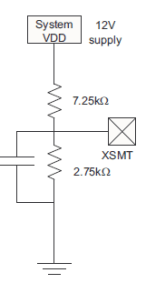ZHCSDC1D September 2013 – October 2018 TAS5766M , TAS5768M
PRODUCTION DATA.
- 1 特性
- 2 应用
- 3 说明
- 4 修订历史记录
- 5 Pin Configuration and Functions
- 6 Specifications
-
7 Detailed Description
- 7.1 Overview
- 7.2 Functional Block Diagram
- 7.3 Feature Description
- 7.4
Device Functional Modes
- 7.4.1 Device Protection System
- 7.4.2 Reset and System Clock Functions
- 7.4.3 System Clock PLL Mode
- 7.4.4 Clock Generation and PLL
- 7.4.5 PLL Calculation
- 7.4.6 Audio Data Interface
- 7.4.7
TAS576xM Audio Processing Options
- 7.4.7.1 Overview
- 7.4.7.2 miniDSP Instruction Register
- 7.4.7.3 Digital Output
- 7.4.7.4 Software
- 7.4.7.5 Process Flow
- 7.4.7.6 Zero Data Detect
- 7.4.7.7 Power Save Modes
- 7.4.7.8 XSMT Pin (Soft Mute/Soft Un-Mute)
- 7.4.7.9 External Power Sense Undervoltage Protection Mode
- 7.4.7.10 Recommended Power Down Sequence
- 7.5 Programming
- 7.6 Register Maps
- 8 Applications and Implementation
- 9 Power Supply Recommendations
- 10Layout
-
11Register Map Information
- 11.1
Detailed Register Map Descriptions
- 11.1.1 Register Map Summary
- 11.1.2
Page 0 Registers
- 11.1.2.1 Page 0 / Register 1 (Hex 0x01)
- 11.1.2.2 Page 0 / Register 2 (Hex 0x02)
- 11.1.2.3 Page 0 / Register 3 (Hex 0x03)
- 11.1.2.4 Page 0 / Register 4 (Hex 0x04)
- 11.1.2.5 Page 0 / Register 7 (Hex 0x07)
- 11.1.2.6 Page 0 / Register 8 (Hex 0x08)
- 11.1.2.7 Page 0 / Register 9 (Hex 0x09)
- 11.1.2.8 Page 0 / Register 10 (Hex 0x0A)
- 11.1.2.9 Page 0 / Register 12 (Hex 0x0C)
- 11.1.2.10 Page 0 / Register 13 (Hex 0x0D)
- 11.1.2.11 Page 0 / Register 20 (Hex 0x14)
- 11.1.2.12 Page 0 / Register 21 (Hex 0x15)
- 11.1.2.13 Page 0 / Register 22 (Hex 0x16)
- 11.1.2.14 Page 0 / Register 23 (Hex 0x17)
- 11.1.2.15 Page 0 / Register 24 (Hex 0x18)
- 11.1.2.16 Page 0 / Register 27 (Hex 0x1B)
- 11.1.2.17 Page 0 / Register 28 (Hex 0x1C)
- 11.1.2.18 Page 0 / Register 29 (Hex 0x1D)
- 11.1.2.19 Page 0 / Register 30 (Hex 0x1E)
- 11.1.2.20 Page 0 / Register 32 (Hex 0x20)
- 11.1.2.21 Page 0 / Register 33 (Hex 0x21)
- 11.1.2.22 Page 0 / Register 34 (Hex 0x22)
- 11.1.2.23 Page 0 / Register 35 (Hex 0x23)
- 11.1.2.24 Page 0 / Register 36 (Hex 0x24)
- 11.1.2.25 Page 0 / Register 37 (Hex 0x25)
- 11.1.2.26 Page 0 / Register 40 (Hex 0x28)
- 11.1.2.27 Page 0 / Register 41 (Hex 0x29)
- 11.1.2.28 Page 0 / Register 42 (Hex 0x2A)
- 11.1.2.29 Page 0 / Register 43 (Hex 0x2B)
- 11.1.2.30 Page 0 / Register 44 (Hex 0x2C)
- 11.1.2.31 Page 0 / Register 59 (Hex 0x3B)
- 11.1.2.32 Page 0 / Register 65 (Hex 0x41)
- 11.1.2.33 Page 0 / Register 66 (Hex 0x42)
- 11.1.2.34 Page 0 / Register 82 (Hex 0x52)
- 11.1.2.35 Page 0 / Register 83 (Hex 0x53)
- 11.1.2.36 Page 0 / Register 84 (Hex 0x54)
- 11.1.2.37 Page 0 / Register 85 (Hex 0x55)
- 11.1.2.38 Page 0 / Register 86 (Hex 0x56)
- 11.1.2.39 Page 0 / Register 87 (Hex 0x57)
- 11.1.2.40 Page 0 / Register 90 (Hex 0x5A)
- 11.1.2.41 Page 0 / Register 91 (Hex 0x5B)
- 11.1.2.42 Page 0 / Register 92 (Hex 0x5C)
- 11.1.2.43 Page 0 / Register 93 (Hex 0x5D)
- 11.1.2.44 Page 0 / Register 94 (Hex 0x5E)
- 11.1.2.45 Page 0 / Register 95 (Hex 0x5F)
- 11.1.2.46 Page 0 / Register 108 (Hex 0x6C)
- 11.1.2.47 Page 0 / Register 118 (Hex 0x76)
- 11.1.2.48 Page 0 / Register 119 (Hex 0x77)
- 11.1.2.49 Page 0 / Register 120 (Hex 0x78)
- 11.1.2.50 Page 0 / Register 121 (Hex 0x79)
- 11.1.3 Page 1 Registers
- 11.1.4 Page 44 Registers
- 11.1
Detailed Register Map Descriptions
- 12器件和文档支持
- 13机械、封装和可订购信息
封装选项
机械数据 (封装 | 引脚)
散热焊盘机械数据 (封装 | 引脚)
- DCA|48
订购信息
7.4.7.9 External Power Sense Undervoltage Protection Mode
The XSMT pin can also be used to monitor a system voltage, such as the 24-VDC LCD TV back light, or 12-VDC system supply using a voltage divider created with two resistors. See Figure 45.
| * | If the XSMT pin makes a transition from “1” to “0” over 6ms or more, the device switches into external undervoltage protection mode. This mode uses two trigger levels. |  |
| * | When the XSMT pin level reaches 2 V, soft mute process begins. | |
| * | When the XSMT pin level reaches 1.2 V, analog mute engages, regardless of digital audio level, and analog shutdown begins. (DAC and related circuitry powers down). | |
| Figure 45. External Power Sense |
A timing diagram describing this is shown in Figure 46.
NOTE
The XSMT input pin voltage range is from –0.3 V to DVDD + 0.3 V.The ratio of external resistors must produce a voltage within this input range. Any increase in power supply (such as power supply positive noise or ripple) can pull the XSMT pin higher than DVDD +0.3V.
For example, if the TAS576xM is monitoring a 12 V input, and dividing the voltage by 4, then the voltage at XSMT during ideal power supply conditions is 3 V. A voltage spike higher than 14.4 V causes a voltage greater than 3.6 V (DVDD+0.3) on the XSMT pin, potentially damaging the device. Providing the divider is set appropriately, any DC voltage can be monitored.
 Figure 46. XSMT Timing for Undervoltage Protection
Figure 46. XSMT Timing for Undervoltage Protection